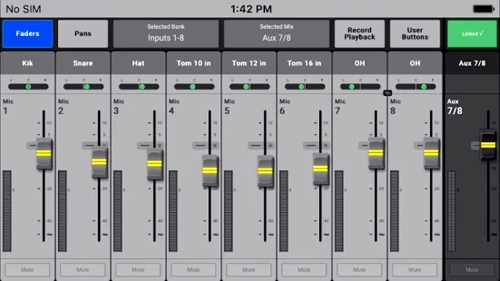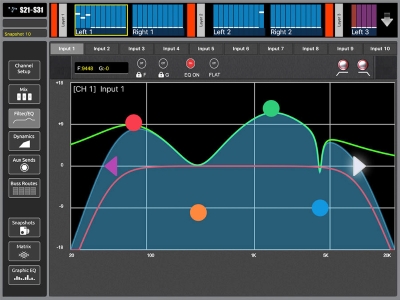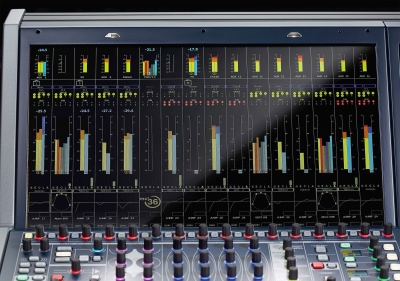
QSC regularly delivers upgrades for the TouchMix compact platform, exemplified by recently released new firmware for the TouchMix-30 Pro that enables the mixer to have direct download for upgrades. It also adds a number of improvements to the parametric EQ (PEQ) operation. When the channel RTA is disabled, the EQ graph now expands vertically to occupy the space that was formerly used for the RTA.
In addition, the Q parameter now responds to a pinching gesture on the touch screen. This function is supported on the mixer as well as the latest release of the TouchMix Control app.
Among other things, maximum LCD brightness has been increased, the monitor pop-up now includes delay settings and source selection buttons, there’s a balance control to the FX returns, and much more.

QSC has also released the TouchMix-30 Pro Microsoft Windows Driver, providing Windows users with the capability to utilize the mixer as a 32 x 32 channel DAW interface.
Previously this functionality was only available to users of macOS systems. And, recently released firmware version 3.0 for TouchMix-8 and -16 mixers adds many of the features found in the larger TouchMix-30.
The latest v2.0 software upgrade for the DiGiCo S-Series consoles delivers an increased channel count for both the S21 and S31 from 40 to 48 input channels. It gives S-Series users 48 mono/stereo switchable flexi-channels, the equivalent to 46 buses at 96 kHz, with no processing limitations.
The upgrade also includes new switching functionality for the order of EQ and dynamics modules, new stereo width and balance controls added to the input processing view for stereo input channels, and more.
In addition, the DiGiCo S-Series app released earlier this year offers wireless control directly from an iPad. The app permanently displays an overview of the console layout, allowing users to select any available console bank and have the same operation they’re familiar with.

Also not to be overlooked is DiGiCo’s Stealth Core 2 upgrade to the Stealth Digital Processing of the SD-Series, supplying enhanced processing from the audio core as well as improvements to both processing channels and functionality. It provides full dynamic EQ, DiGiTuBes, and MB dynamics on every channel and bus, and more, and is available as an upgrade option for existing users and shipping as standard on new consoles.
The latest from Allen & Heath is firmware v1.6, code-named Fistral, for the company’s flagship dLive mix systems. It adds automatic mic mixer (AMM) features, multi-surface capability, support for a range of new installation hardware, and new DEEP processing models.

AMM can handle up to 64 microphones, with the facility to assign mics to four different AMM configurations when running multiple conference rooms or panel discussions. The system offers two distinct modes: classic gain sharing and a number of open mics (NOM) algorithm.
Multi-surface capability with gain tracking allows up to four independent dLive surfaces to control a single MixRack, opening up possibilities such as front of house/monitor splits, sidecar mixing, and surface redundancy.
Version 1.6 also adds support for the recently launched range of dLive hardware for installed sound, including the compact DM0 MixRack, GPIO interface, IP1 wallplate controller and new DX expanders, hubs and modules. And, the new firmware enables Internet access to dLive systems for remote control and diagnostics.

Allen & Heath also provides different apps for its various mixer series, including three for the Qu Series: Qu-Pad for iPads offers access to all live mix parameters, Qu-You allows up to seven performers to control their monitor mixes using an iPhone, iPad, iPod Touch or Android device, and Qu-Control supplies simple configuration of up to five screens with up to 15 control “widgets” each for application, such as background music source selection, master zone level, scene recall, and mic paging.
Lawo recently delivered a set of new features for its mc2 Series consoles with software release 5.8, headed by Module ISO that enables users to prevent certain settings from being loaded from snapshots as well as to create partial snapshots that only affect certain channels or modules. The update also provides RAVENNA AoIP integration for Neumann DMI-8 digital mic interfaces.
In addition, Lawo has added support for 96 kHz RAVENNA operation plus network-optimized gain compensation, along with a significant theater automation update and the Lawo 981/65 Dante card.
Further, the company now offers an upgraded version of the Remote App for iOS, which enables many of the functions of Lawo HD-core-based systems to be controlled remotely – for example, from a theater stage or from around an auditorium, or from any location with a WLAN connection. Further, the app allows control of all source- and target-related settings, and users can load snapshots and pre-configured functions.
